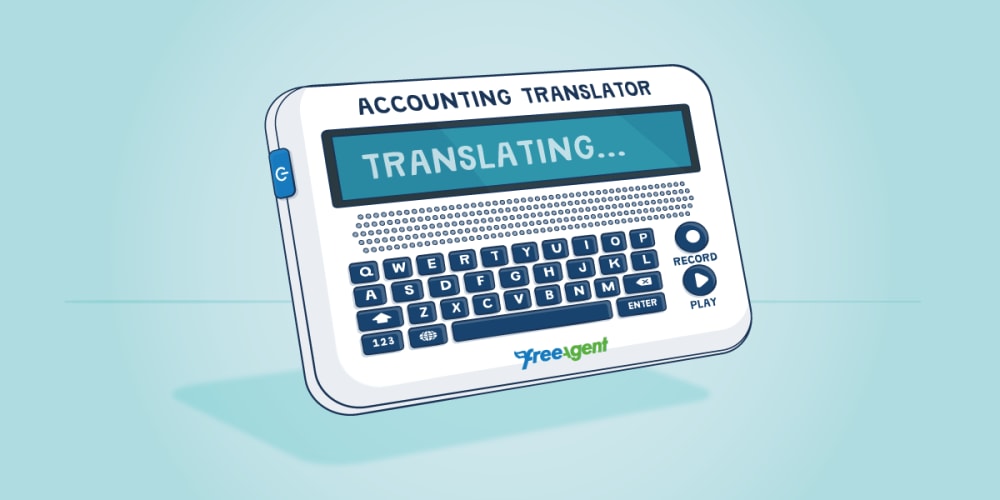5 confusing pieces of accounting terminology explained

Running a business is hard enough without having to wrap your head around complicated financial jargon. Luckily, our accounting glossary is packed full of simple explanations to help you translate complex accounting vocabulary into something simpler.
To help you feel more confident the next time you’re talking to an accountant, we’ve picked out five terms that often leave people perplexed.
1. Payments on account
If there’s one surprise you don’t want, it’s one where tax is involved. But that’s what some new business owners get when they discover payments on account.
What are they?
Payments on account are payments of Income Tax and Class 4 National Insurance contributions that some business owners have to make before their next Self Assessment tax return is due. If your last tax bill was more than £1,000 and you paid less than 80% of your Income Tax at source, you will have to make payments on account.
Payments on account are due on 31st January and 31st July every year. They are calculated as half the previous year’s combined tax and class 4 National Insurance liability.
If you end up owing more or less than you’ve paid on account when you submit your tax return for the year, HMRC will either refund the difference or ask you to make a balancing payment.
Why do I need to know about them?
If you’re required to make payments on account, it will impact how much money your business needs to set aside to pay HMRC.
It is especially important for new business owners. In their first year, they may have to pay tax on their first-year trading and make payments on account towards next year’s bill.
Check out our guide on payments on account for more detail and examples of how they work in practice.
2. Proforma invoice
If you need to provide a customer with an idea of a potential cost before you have a final figure, a proforma invoice could be useful.
What is it?
A proforma invoice is a document that you can give to a customer if they need an indication of price while you’re negotiating the exact terms or scope of a sale.
Like an estimate, a proforma invoice gives the customer a sense of what they might need to spend, but it’s not a quotation and you’re not obliged to provide the goods or services at the stated price.
Why do I need to know about them?
Proforma invoices are useful because they can help a customer get budget approval for a purchase from your business.
However, a proforma invoice is for information only and the final amount may change. It shouldn’t be added to your accounts and the amount shouldn’t appear as part of your sales or your list of debtors.
3. Solvency ratio
In a nutshell, a business’s solvency ratio provides a measure of its ability to pay its debts.
What is it?
The solvency ratio is a calculation that can predict whether a business’s cashflow is sufficient for it to be able to meet its long-term debt. Generally speaking, a solvency ratio of above 20% is considered to be financially healthy. But the lower the ratio, the more likely the business is to default on its debt obligations.
Why do I need to know about it?
Every business has a solvency ratio. It can be used to decide whether to do business with another organisation. If your business’s solvency ratio is low, you may find it harder to borrow money.
4. VAT Flat Rate Scheme
The VAT Flat Rate Scheme is designed to simplify VAT admin for certain types of small business.
What is it?
The VAT Flat Rate Scheme is an alternative way to pay VAT to HMRC. Instead of paying the difference between the VAT you’ve charged to your customers and the VAT you’ve paid to suppliers, under the Flat Rate Scheme you simply pay a percentage of your total sales to HMRC. The percentage you apply will depend on your business type.
To join the scheme, your business must have VATable sales of less than £150,000 (excluding VAT). You can apply via HMRC.
Why do I need to know about it?
If you run a small business, VAT admin can sometimes be confusing. The VAT Flat Rate Scheme could help you simplify your accounts, but it might not be the most cost-effective approach in terms of what you end up owing, so speak to your accountant for advice. Find out more about how the VAT Flat Rate Scheme works in our dedicated guide.
5. Mutuality of Obligation
If you like a satisfying acronym, you’ll love Mutuality of Obligation, also known as ‘MOO’.
What is it?
MOO is a legal term that refers to the mutual obligation of employers to provide work for their employees and for the employees to carry out the work that is provided. It’s the standard way that jobs operate: the employer provides work and the employee does that work.
Why do I need to know about it?
The existence of MOO in a contract determines whether someone is an employee or not. This is important as only employees get certain employment rights. It is also relevant to determining whether someone should be taxed as an employee or self-employed.
Try a 30-day free trial of FreeAgent and find out how our award-winning accounting software can help you stay on top of your admin and give you more time back to focus on your business.
Disclaimer: The content included in this blog post is based on our understanding of tax law at the time of publication. It may be subject to change and may not be applicable to your circumstances, so should not be relied upon. You are responsible for complying with tax law and should seek independent advice if you require further information about the content included in this blog post. If you don't have an accountant, take a look at our directory to find a FreeAgent Practice Partner based in your local area.


